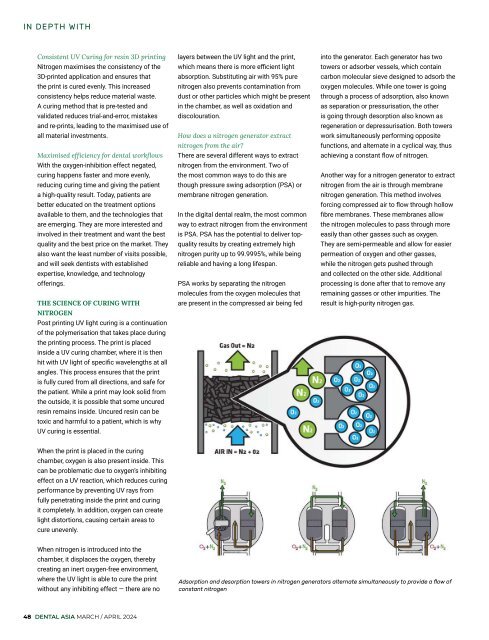Dental Asia March/April 2024
For more than two decades, Dental Asia is the premium journal in linking dental innovators and manufacturers to its rightful audience. We devote ourselves in showcasing the latest dental technology and share evidence-based clinical philosophies to serve as an educational platform to dental professionals. Our combined portfolio of print and digital media also allows us to reach a wider market and secure our position as the leading dental media in the Asia Pacific region while facilitating global interactions among our readers.
For more than two decades, Dental Asia is the premium journal in linking dental innovators
and manufacturers to its rightful audience. We devote ourselves in showcasing the latest dental technology and share evidence-based clinical philosophies to serve as an educational platform to dental professionals. Our combined portfolio of print and digital media also allows us to reach a wider market and secure our position as the leading dental media in the Asia Pacific region while facilitating global interactions among our readers.
Create successful ePaper yourself
Turn your PDF publications into a flip-book with our unique Google optimized e-Paper software.
IN DEPTH WITH<br />
Consistent UV Curing for resin 3D printing<br />
Nitrogen maximises the consistency of the<br />
3D-printed application and ensures that<br />
the print is cured evenly. This increased<br />
consistency helps reduce material waste.<br />
A curing method that is pre-tested and<br />
validated reduces trial-and-error, mistakes<br />
and re-prints, leading to the maximised use of<br />
all material investments.<br />
Maximised efficiency for dental workflows<br />
With the oxygen-inhibition effect negated,<br />
curing happens faster and more evenly,<br />
reducing curing time and giving the patient<br />
a high-quality result. Today, patients are<br />
better educated on the treatment options<br />
available to them, and the technologies that<br />
are emerging. They are more interested and<br />
involved in their treatment and want the best<br />
quality and the best price on the market. They<br />
also want the least number of visits possible,<br />
and will seek dentists with established<br />
expertise, knowledge, and technology<br />
offerings.<br />
THE SCIENCE OF CURING WITH<br />
NITROGEN<br />
Post printing UV light curing is a continuation<br />
of the polymerisation that takes place during<br />
the printing process. The print is placed<br />
inside a UV curing chamber, where it is then<br />
hit with UV light of specific wavelengths at all<br />
angles. This process ensures that the print<br />
is fully cured from all directions, and safe for<br />
the patient. While a print may look solid from<br />
the outside, it is possible that some uncured<br />
resin remains inside. Uncured resin can be<br />
toxic and harmful to a patient, which is why<br />
UV curing is essential.<br />
layers between the UV light and the print,<br />
which means there is more efficient light<br />
absorption. Substituting air with 95% pure<br />
nitrogen also prevents contamination from<br />
dust or other particles which might be present<br />
in the chamber, as well as oxidation and<br />
discolouration.<br />
How does a nitrogen generator extract<br />
nitrogen from the air?<br />
There are several different ways to extract<br />
nitrogen from the environment. Two of<br />
the most common ways to do this are<br />
though pressure swing adsorption (PSA) or<br />
membrane nitrogen generation.<br />
In the digital dental realm, the most common<br />
way to extract nitrogen from the environment<br />
is PSA. PSA has the potential to deliver topquality<br />
results by creating extremely high<br />
nitrogen purity up to 99.9995%, while being<br />
reliable and having a long lifespan.<br />
PSA works by separating the nitrogen<br />
molecules from the oxygen molecules that<br />
are present in the compressed air being fed<br />
into the generator. Each generator has two<br />
towers or adsorber vessels, which contain<br />
carbon molecular sieve designed to adsorb the<br />
oxygen molecules. While one tower is going<br />
through a process of adsorption, also known<br />
as separation or pressurisation, the other<br />
is going through desorption also known as<br />
regeneration or depressurisation. Both towers<br />
work simultaneously performing opposite<br />
functions, and alternate in a cyclical way, thus<br />
achieving a constant flow of nitrogen.<br />
Another way for a nitrogen generator to extract<br />
nitrogen from the air is through membrane<br />
nitrogen generation. This method involves<br />
forcing compressed air to flow through hollow<br />
fibre membranes. These membranes allow<br />
the nitrogen molecules to pass through more<br />
easily than other gasses such as oxygen.<br />
They are semi-permeable and allow for easier<br />
permeation of oxygen and other gasses,<br />
while the nitrogen gets pushed through<br />
and collected on the other side. Additional<br />
processing is done after that to remove any<br />
remaining gasses or other impurities. The<br />
result is high-purity nitrogen gas.<br />
When the print is placed in the curing<br />
chamber, oxygen is also present inside. This<br />
can be problematic due to oxygen’s inhibiting<br />
effect on a UV reaction, which reduces curing<br />
performance by preventing UV rays from<br />
fully penetrating inside the print and curing<br />
it completely. In addition, oxygen can create<br />
light distortions, causing certain areas to<br />
cure unevenly.<br />
When nitrogen is introduced into the<br />
chamber, it displaces the oxygen, thereby<br />
creating an inert oxygen-free environment,<br />
where the UV light is able to cure the print<br />
without any inhibiting effect — there are no<br />
Adsorption and desorption towers in nitrogen generators alternate simultaneously to provide a flow of<br />
constant nitrogen<br />
48 DENTAL ASIA MARCH / APRIL <strong>2024</strong>

















